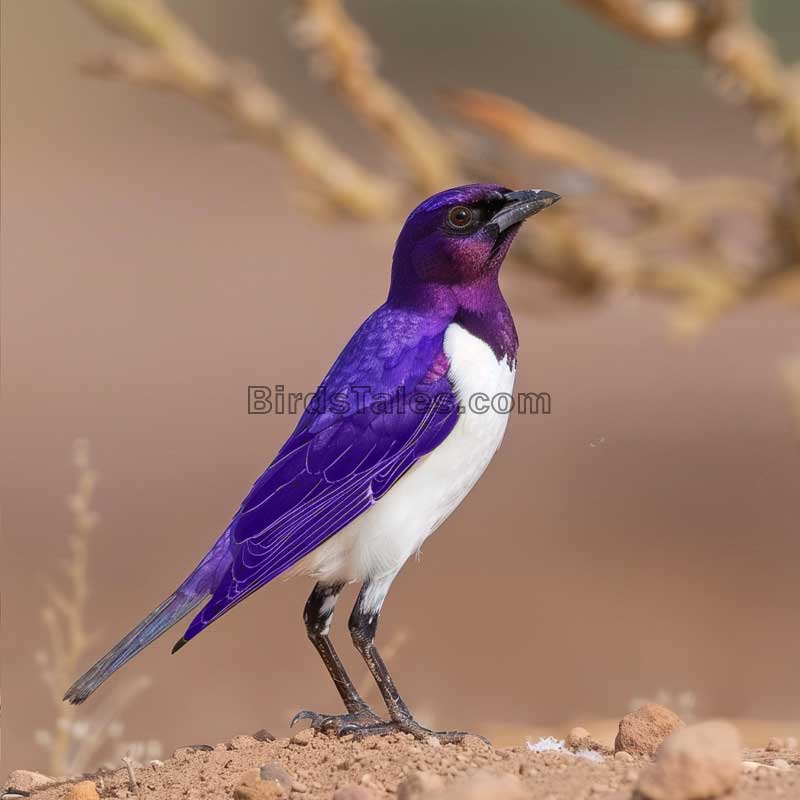Key Habitats of the Violet Starling
The violet starling thrives in particular types of areas.
Here are the main habitats where you can find them:
Open Woodlands
Open woodlands are a preferred home for violet starlings.
These areas provide ample food and nesting spots.
Trees in these regions are not too dense, allowing easy access to insects and fruits, which are vital food sources.
The mixture of trees and open spaces is ideal for their foraging habits.
Birds need space to spread their wings, right?
Open woodlands are perfect for that.
These woodlands are common in regions like Zambia and Malawi.
The presence of trees and open spaces makes it easy for the violet starling to find insects, which are a primary food source.
The balance of canopy cover and open areas supports their need for both shelter and food.
Birds thrive in various environments. These places, called habitats, give birds the essentials for life. Food, water, shelter, and nesting…
Gallery Forests
Gallery forests, which line rivers, are another critical habitat.
These forests offer plenty of food and materials for nesting.
The cover provided by these trees is essential for their safety and breeding.
Imagine a cozy riverside retreat, perfect for a bird.
Sounds ideal, doesn’t it? In the Congo Basin and Kenya’s Chyulu Hills, gallery forests are common.
They offer a constant supply of water, ensuring the availability of insects and fruits throughout the year.
The lush, green surroundings provide ample nesting materials, which is crucial during the breeding season.
These forests also act as natural barriers against predators, giving the violet starling a safe haven.
Forest Edges and Clearings
Violet starlings also favor forest edges and clearings.
These spaces are ideal for foraging.
The mix of trees and open areas helps them find food easily and nest safely.
Think of it as the best of both worlds – shelter from the trees and easy access to food in the open.
Forest edges are rich in insects and fruits, making them a preferred foraging ground.
The birds can quickly move between the trees and open areas, ensuring they are well-fed and protected.
Forest edges and clearings are common in South Africa and Tanzania, providing the birds with diverse food sources and nesting options.
Birds thrive in various environments. These places, called habitats, give birds the essentials for life. Food, water, shelter, and nesting…
Geographical Spread and Seasonal Adaptations
Violet starlings are spread across sub-Saharan Africa.
Their presence and behavior change with seasons and regions.
Presence in Sub-Saharan Africa
You can find violet starlings in several countries:
- Kenya: Chyulu Hills
- Congo Basin
- Tanzania
- Zambia
- Malawi
- Mozambique
- South Africa
These regions offer the perfect blend of habitats.
In Kenya, the Chyulu Hills provide an excellent mix of open woodlands and gallery forests.
In the Congo Basin, the dense forests offer safety and ample food supplies.
The varied environments across these countries ensure that the violet starling can thrive.
Each region provides a unique set of resources, from the arid parts of southwestern Africa to the lush forests of the Congo Basin.
The birds have adapted to these different habitats, ensuring their survival and growth.
Desert Habitat of the Greater Roadrunner
The Greater Roadrunner (Geococcyx californianus) is a unique bird native to the Desert Southwest of North America. It is known…
Seasonal Movements
Violet starlings may move depending on the season.
These movements are often in response to changes in food availability and habitat conditions.
During the dry season, they might move to areas with more water sources, like gallery forests.
In the wet season, they can be found in open woodlands, where food is plentiful.
Birds, like people, know where to find the best grub.
Their seasonal movements ensure they always have access to food and suitable nesting sites.
This adaptability is crucial for their survival, especially in regions with significant seasonal variations.
Habitat Conservation and Challenges
Conserving the violet starling’s habitat is crucial.
These birds face several threats, but efforts are underway to protect them.
Threats to Habitat
The main threats include:
- Deforestation
- Land development
These activities destroy their homes and reduce their population.
It’s like losing your home overnight.
Deforestation is rampant in many parts of sub-Saharan Africa, driven by agriculture and logging.
Land development for urban areas further reduces the natural habitats available to these birds.
As forests are cleared, the birds lose their nesting sites and food sources.
This leads to a decline in their population and disrupts the ecological balance.
Conservation Initiatives
Several initiatives aim to protect violet starling habitats.
Effective strategies include:
- Protected areas
- Reforestation projects
You can help by supporting these efforts and spreading awareness.
Protected areas ensure that crucial habitats are preserved, while reforestation projects help restore lost forests.
Every tree planted is a step towards saving these beautiful birds.
Conservation organizations work tirelessly to create and maintain these protected areas.
Local communities are often involved in these efforts, ensuring sustainable practices that benefit both people and wildlife.
By supporting these initiatives, you can contribute to the preservation of the violet starling and its habitat.
Conclusion
The violet starling’s habitat needs are specific and crucial for their survival.
Protecting these areas is essential.
Continued research and conservation efforts will ensure that these beautiful birds continue to thrive.
| Habitat Type | Key Features | Importance |
|---|---|---|
| Open Woodlands | Sparse trees, insects, fruits | Food, nesting |
| Gallery Forests | Trees along rivers, nesting materials | Safety, breeding |
| Forest Edges | Mix of trees and open areas | Foraging, nesting |
| Clearings | Open spaces within forests | Easy access to food |
Important Note: Protecting these habitats ensures the survival of the violet starling.
Support conservation efforts and spread the word.



